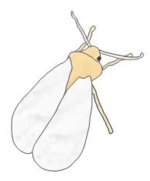Whiteflies in the Greenhouse
ENTFACT-456: Whiteflies in the Greenhouse | Download PDF
by Jen White, Extension Entomologist
University of Kentucky College of Agriculture
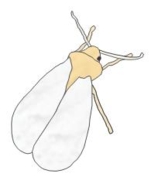
General Biology
Whiteflies are “true bugs” (Hemiptera) that feed on plant sap, much like aphids. Adults are very small (1/16 - 1/10 inch) with powdery white wings. Females lay eggs directly on the undersides of plant leaves. The eggs hatch into tiny “crawlers” that walk a short distance before settling at a feeding location. These nymphs lose their ability walk, and remain in the same location for the rest of their development until they pupate and emerge as winged adults (Figure 1). The entire whitefly life cycle takes about 3 weeks under favorable conditions, allowing populations to build quickly. Whiteflies do not have a dormant stage that can withstand freezing temperatures. In climates that have winter freezes, such as Kentucky, whiteflies are year-round pests only in greenhouses.
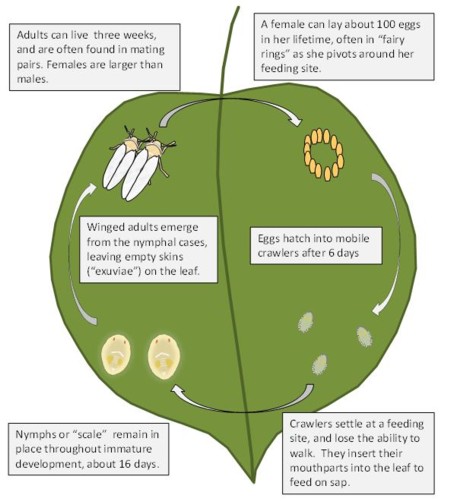
Figure 1. Lifecycle of the sweetpotato whitefly, entirely on the undersides of leaves. Development times in the figure are for 77°F on a preferred host plant species. Each stage will be longer at colder temperatures, or on a less preferred crop. Adults, eggs, and young nymphs are usually found on fresh newly expanded leaves, whereas older nymphs and exuviae are found on more mature foliage.
Worldwide, there are over 1500 species of whitefly, most of which are inconspicuous and never reach densities high enough to cause damage to their host plants. A few species, however, are major pests. Here in Kentucky, the most notable are 1) the sweetpotato whitefly (Bemisia tabaci), and 2) the greenhouse whitefly (Trialeurodes vaporarorium). The former is a confusing complex of “biotypes” (currently considered multiple species) that are physically indistinguishable, but which have distinct biological differences. For example, B biotype is also sometimes known as the silverleaf whitefly (also known as Bemisia argentifolii) because of the distinctive silvering damage it inflicts on plant leaves. B biotype is currently the most common in North America, but a second biotype, Q biotype, is also present, and of particular concern because Q biotype is highly resistant to many classes of insecticide. Finally, a third species, the bandedwinged whitefly (Trialeurodes abutiloneus) is an occasional pest of greenhouses. Other whitefly species are possible in the greenhouse (particularly on specialty crops such as citrus), but most of the time the culprit is one of these 3 species.
Damage Inflicted
Whiteflies are sap feeders that reduce the overall vigor of plants with their feeding. As whitefly infestations become severe, they cause plants to yellow and lose their leaves prematurely. They also produce large amounts of sticky, sugary honeydew, which in turn is colonized by black sooty mold, reducing the attractiveness and marketability of whitefly-infested crops.
Even worse, whiteflies are vectors that transmit over a hundred different plant viruses. The viruses are taken up by whiteflies feeding on an infected plant. When the whitefly moves to a new plant and starts feeding, viral particles enter the plant and start a new infection cycle. Plant species differ widely in both their susceptibility to these viruses and the symptoms they show. At the extremes, some plants species show no symptoms of infection (carriers) and other plant species become completely unmarketable. Of the greenhouse pest species of whitefly, sweetpotato whitefly is responsible for transmission of most viruses, but all three whiteflies can transmit viruses that can be damaging to crops. In general, whitefly vectored viruses are more frequently associated with vegetable than ornamental crops in the greenhouse.
Identification of Different Whitefly Species
Because different pest whitefly species differ in their susceptibility to control methods (see below) as well as the level of damage they can inflict, it is important to identify which species is infesting your greenhouse. You’ll need a handlens or magnifying glass to aid identification.

Figure 2. Species identification for common whiteflies in the greenhouse.
As adults, bandedwinged whiteflies are easily distinguished from sweetpotato and greenhouse whiteflies by the presence of a dark zig-zag pattern across the wings (Figure 2). Sweetpotato and greenhouse whiteflies are both solid white, but can be distinguished from one another as adults by the way they hold their wings. Greenhouse whitefly holds its wings out flat, giving it a triangular appearance from above, whereas sweetpotato whitefly holds its wings tentlike over its body at a sharp angle, giving the whitefly a more linear appearance from above, like a tiny grain of rice.
Fortunately, the immature “scale” of greenhouse and sweetpotato whitefly is easier to distinguish. Greenhouse whitefly nymphs are shaped like a pillbox, oval with flat perpendicular sides, and with noticeable long waxy filaments on the top. In contrast, nymphal sweetpotato whiteflies lack the perpendicular sides, lying more flat against the leaf. They also have only a few delicate filaments, which are quite hard to see. Bandedwinged nymphs look like greenhouse whitefly nymphs, but lack the long projecting filaments, instead having curly filaments on the top surface.
What Plants Might Be Attacked?
The list of plant species attacked by these pest whitefly species is unfortunately long. Table 1 includes some of the most important greenhouse crops attacked, but is far from complete. Sweetpotato whitefly is known to attack more than 700 species, and greenhouse whitefly is not much better. Bandedwinged whitefly has a more restricted host range, and while it may feed on many plants in the greenhouse, it won't lay eggs on many crop species. Large numbers of adult bandedwinged whiteflies may enter greenhouses in the fall when vegetation in the landscape starts to die back, but will not necessarily become a persistent pest problem. That said, some greenhouse crops are known to sustain bandedwinged whitefly populations (Table 1). Additionally, bandedwinged whiteflies can reproduce on some species of weeds, such as beggarticks and ragweed, thus producing a continuous supply of adults to attack and weaken nearby crops.
Table 1: Some preferred greenhouse hostplants of whiteflies
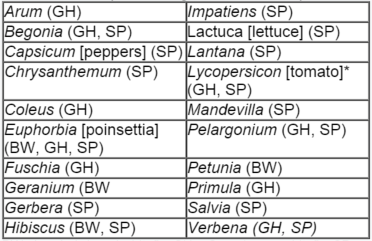
BW= bandedwinged whitefly, GH = Greenhouse whitefly, SP = sweetpotato whitefly
*particularly prone to whitefly-vectored viruses
Integrated Pest Management
Prevention
The old adage "an ounce of prevention is worth a pound of cure" (Benjamin Franklin) is certainly true when it comes to pest infestations of greenhouses. The following tips can help prevent infestations before they ever start:
Isolation/examination of new stock. Most whitefly outbreaks can be traced back to infested stock material. When new plants are brought in to the greenhouse, keep them isolated in a separate bay (best), bench, or area of the greenhouse. Because whitefly eggs and young nymphs are so small, it is very easy to miss early infestations. If new stock can be kept isolated for a period of 1-2 weeks, this allows time for larger nymphs to develop, which will be easier to detect. Use a hand lens or magnifying glass to check the undersides of young leaves before integrate new material with more established crops.
Screening. During warm dry seasons, whiteflies can become abundant in the environment, and may colonize greenhouses directly through open doors, windows and ventilation. Exclusion through screening may not always be feasible, but features such as double-door entry and covered ventilation could be considered in the construction of new greenhouses.
Sanitation. Remove plant residues from within and near the greenhouse. Whitefly nymphs can continue to mature on dead/dying plant material, producing adults that can reinfest crops. Some weed species are also favored hosts for whiteflies, so removing weeds from around (and within) the greenhouse makes it more difficult for whiteflies to cycle between greenhouse crops and the surrounding environment.
Crop free period. Because all stages of the whitefly life cycle are dependent on plants, allowing the greenhouse to stand empty of plants can also break the cycle of re-colonization and infestation. Adult whiteflies cannot live without feeding on a host plant (for more than a few days), so even a week at warm temperatures without plants should be sufficient to remove potential whitefly colonists from the greenhouse. In cooler temperatures, the plant-free period needs to be longer, so consider warming up the greenhouse for a few days prior to introducing a new crop, to purge and remnant populations. Once pest-free crops are established, avoid accidentally introducing "hitch-hiker" whiteflies as you move among greenhouses or bays. Avoid wearing colors that are attractive to whiteflies (yellow and blue), brush yourself off before entering clean areas, and try to avoid moving directly from infested to uninfested greenhouse areas.
Monitoring
As with most greenhouse pests, early detection of whitefly infestations is difficult due to the small size of the insect, as well as the preferred feeding location on the undersides of leaves. Yet, managing infestations is much easier when they are noticed early, so it is worth investing some time into monitoring efforts.
Yellow sticky cards are an essential tool for monitoring whitefly populations. These can be purchased in small quantities from most garden supply vendors. If you want to purchase in larger quantities, check out some of the vendors listed in Entfact 124, Vendors of microbial and botanical insecticides and insect monitoring devices.
Place the cards in a vertical orientation, so that the card is level with the new plant growth at the top of the crop. About 1-4 cards should be placed every 1000 ft2 of greenhouse, with extra cards placed near doors and vents where whiteflies might enter the greenhouse. In greenhouses with mixed crop species, higher card density should be used around crops that are particularly attractive to whiteflies.
Conduct regular scouting trips (weekly) through the greenhouse, inspecting both the yellow cards and plants. Look for unthrifty yellowing of plants, premature leaf drop, or sticky honeydew on the leaves. If you see these symptoms, use a handlens to inspect the plant more closely for insect infestations. Adult whiteflies will flutter away from plants if disturbed, so brushing your hand through the plant canopy in areas of concern may allow you to find hotspots of whitefly infestation.
Remember that finding a single whitefly on a yellow sticky card does not mean you should immediately apply a chemical control. Unnecessary chemical use is bad for the environment, human health, and the pocketbook. However, whitefly populations are easier to control when small, so don’t ignore early warning signs, either. Intensify monitoring efforts, and develop a plan of action for treatment. General “action threshold” pest densities such as 0.5 whiteflies/sticky card/day for young crops, or 2 whiteflies/sticky card/day for mature crops represent a starting point. However, the precise threshold at which action should be taken depends on many factors. Some crops are more forgiving of light levels of infestation than others, and some control methods take longer to take effect than others. In particular, if you plan to use biological control, it is better to act very early, perhaps even preventatively. Whatever action thresholds and control methods you use, keep records from year to year, so that you have more information about what worked (and what didn’t), to improve your future decisions.
Control
Biological control. Biological control is often successfully used to suppress whitefly populations in greenhouses in Europe, but is less widespread in the United States. Currently, the following biological control agents for whitefly are available in the US:
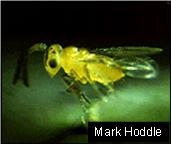
Encarsia formosa
Encarsia formosa is a parasitoid that lays its eggs in whitefly nymphs. It is even smaller than the whiteflies it attacks. The parasitoid larva develops within whitefly nymph, consuming it from the inside over a period of 1-2 weeks. This parasitoid will attack all 3 of the pest whiteflies discussed in this bulletin, but provides the best control against greenhouse whitefly, especially at cooler temperatures. Most commercially-available strains of this parasitoid do not provide good control of sweetpotato whitefly.
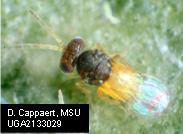
Eretmocerus eremicus
Eretmocerus eremicus is another parasitoid that is commercially available. It is generally considered to provide better control of sweetpotato whitefly than Encarsia inaron, and to perform better at higher temperatures.
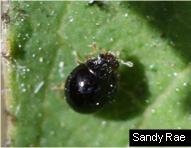
Delphastus catalinae
Delphastus catalinae is a tiny predatory beetle (1/15 inch) that consumes whitefly eggs and nymphs. It will attack all species of whitefly, but prefers sweetpotato whitefly. It avoids eating whitefly nymphs that have parasitoids developing within them, which means that it can be released together with a parasitoid without interfering with parasitism.
Biological control is generally more expensive than chemical control, and won’t result in complete elimination of the pest. However, if you have a history of whitefly infestations that do not respond well to chemical controls, biological control may be able to accomplish what chemicals cannot. Moreover, organic biological control can add value to your crop. If you are considering biological control, carefully discuss your situation with a distributor of biological control organisms, who should be willing to help you use their products as effectively as possible. Vendors of these biological control organisms are listed in Entfact 125.
Chemical control. There are a number of chemicals labeled for whitefly control in the greenhouse in Kentucky (Table 2). These chemicals vary widely in their mode of action, crops they can be used on, compatibility with biological control, and efficacy.
“Resistant” pest populations develop when they are repeatedly and heavily exposed to the same chemical, killing off all but the few rare individuals that differ genetically in such a way that the chemical doesn’t affect them. These survivors reproduce, and their offspring inherit their resistance to the chemical. There are no “magic bullet” pesticides that won’t cause resistance. The solution is rotation: switching among chemicals with different modes of action to kill off survivors of the previous chemical. The mode of action is indicated by the IRAC code in Table 2. Rotating among chemicals within the same IRAC group is not helpful, because survivors of one chemical will probably also survive a second chemical that works in the same way. Likewise, there is no benefit to tank mixing chemicals with the same mode of action. Be sure to carefully follow label “resistance management” restrictions for application frequency. These guidelines have been put in place to prevent widespread resistance to particular chemical groups, to preserve the usefulness of the chemical.
Table 2. Chemicals for control of whitefly in the greenhouse
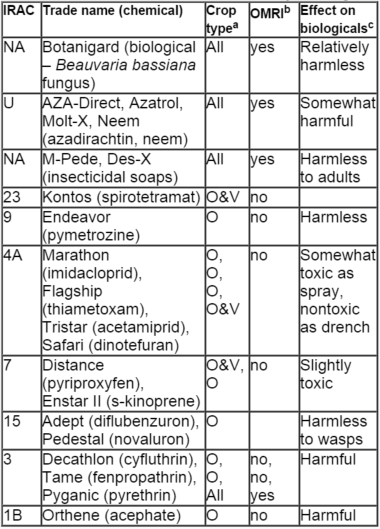
aO = ornamental, V = vegetable
bOMRI = Organic Materials Review Institute
cBiologicals = predatory and parasitoid insects.
If integrating chemical controls with biological controls, carefully consider the compatibility to the two control methods. As you might expect, insecticides are not generally good for beneficial insects, but some are worse than others. For example, insect growth regulators (IRAC code 7) are much more compatible with biological control than pyrethroids (IRAC code 3). Also note that organic (OMRI-certified) pesticides are not necessarily compatible with biological control. Chemicals with less residual activity in the crop and greater selectivity for particular groups of pests are more likely to be successfully integrated into a biological control program.
The diversity of ornamental crops in greenhouses poses particular challenges for pesticide use. When starting use of a new pesticide, you should initially apply it to only a small number of your plants. Monitor these plants for a few days for signs of phytotoxicity before treating the rest of your crop.
References:
Hoddle, M. Silverleaf whitefly, Bemisia argentifolii. http://biocontrol.ucr.edu/bemisia.html
Greer, L. 2000. Greenhouse IPM: sustainable whitefly control. https://attra.ncat.org/attra-pub/viewhtml.php?id=51
Osborne, L. 2012. Pest alert: whiteflies. http://solutionsforyourlife.ufl.edu/hot_topics/agriculture/whiteflies.shtml
Sabaratnam, S. 2012. Emerging virus diseases of greenhouse vegetable crops.
White, J. A. and D. Johnson. 2012. Entfact 124: Vendors of microbial and botanical insecticides and insect monitoring devices. ENTFact-124.
White, J. A. and D. Johnson. 2010. Entfact 125: Vendors of beneficial organisms in North America. ENTFact-125.
Zalom, F. G., J. T. Trumble, C. F. Fouche, C. G. Summers. 2011. UC IPM Pest management guidelines: tomato. http://www.ipm.ucdavis.edu/PMG/r783301211.html
Issued: 5/31/2013
CAUTION! Pesticide recommendations in this publication are registered for use in Kentucky, USA ONLY! The use of some products may not be legal in your state or country. Please check with your local county agent or regulatory official before using any pesticide mentioned in this publication.
Of course, ALWAYS READ AND FOLLOW LABEL DIRECTIONS FOR SAFE USE OF ANY PESTICIDE!
Images: University of Kentucky College of Agriculture
